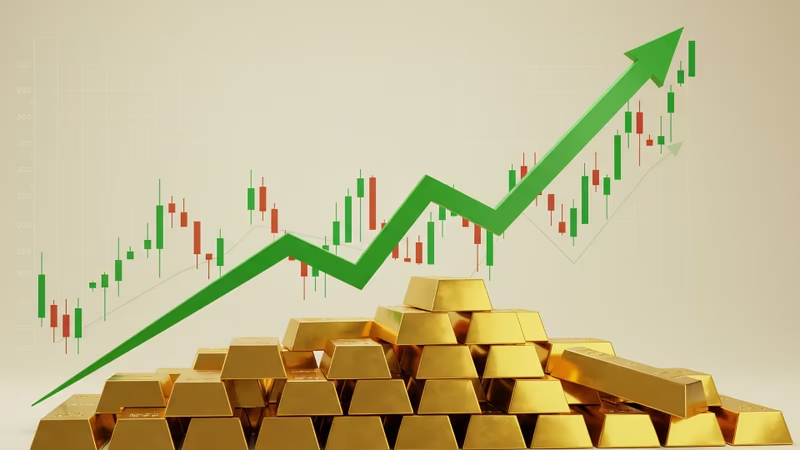In 2024 and 2025, gold has experienced a sizeable rally and reached record highs in both the international and domestic markets.
In 2024, gold experienced a significant surge, with prices rising approximately 25.5% for the year. This marked the metal's best annual performance in 14 years.
As of May 12, 2025, gold has continued its upward trajectory, delivering a 25% return year-to-date. Prices reached an all-time high of $3500/oz (~₹99350) in April before a pullback to around $3200 (~₹92400).
This rally in gold is due to a confluence of factors, including economic reasons, geopolitical reasons, and reasons specific to the market itself. The following are the primary reasons driving gold prices up:
1. Ongoing Geopolitical Tensions
There are continued geopolitical conflicts, including the Russia-Ukraine war and the ongoing tensions in the Middle East and the South China Sea, that have generated a high level of global uncertainty.
Gold, by its traditional measure, is a risk-off asset, and during times of geopolitical uncertainty, gold will attract its traditional breed of investor.
2. U.S.–China Trade War Escalation
In early 2025, the re-escalation of tariffs and retaliatory measures between the U.S. and China created fresh concerns over global trade and economic growth.
Investors have shifted towards gold to hedge against policy unpredictability and potential currency volatility.
3. Central Bank Buying
Many central banks, particularly in emerging economies like China, Russia, and India, have increased their gold reserves, intending to decrease their reliance on the U.S. dollar.
The average annual metric tons of global gold central bank purchases have provided a booster to prices on a steady demand profile and offer, demand composition allude to features that improve the price of gold, but we will return to those later.
4. Inflation Hedge
High inflation in many major economies, including the U.S. and Europe, encourages investors to consider gold as an inflation hedge.
Real returns on fixed-income assets in this environment are very low or even negative, and gold provides a better means to store wealth.
Save your money in digital gold today for a secure financial future with the Jar app!
5. Weakening U.S. Dollar
The U.S. dollar exhibited major weakness against other major global currencies in 2024–2025, stemming from dovish messages from the Federal Reserve and issues surrounding the federal budget.
Since gold is traded in dollars, the weaker dollar effectively makes gold less costly to international buyers, leading to price increases.
6. Anticipation of Fed Rate Cuts
Growing speculation that the U.S. Federal Reserve will pause or even cut interest rates to stimulate economic activity has caused demand for gold to rise.
Lower interest rates diminish the opportunity cost of holding non-interest-bearing assets like gold.
7. Strong retail and digital demand
Gold buying around customary Indian festivals like Akshaya Tritiya and the wedding season continues to stay strong, and the rise of portals to purchase digital gold has also allowed accessibility for millennial tech-savvy investors, also bolstering demand.
8. Increased Volatility in Equity Markets
The uncertainty of the equity markets amid fears of economic slowdown and concern over corporate earnings has increased the demand for safer assets like gold, which impacts the demand for gold upward and the price of gold upward.
9. Institutional Safe-Haven Demand
Institutional investors, from pension funds to hedge funds, are increasing gold allocations in their portfolio management strategies as a risk management strategy. The large inflows into ETFS have contributed to sustained upward pressure on prices.
10. Supply Constraints
Mining production remains, on the whole, quite stagnant, and supply chain disruptions have continued to permeate into some regions due to COVID and regional conflicts. While demand has shown an increase and supply remains tight in terms of production, reason dictates an upward price movement.
The gold market in 2025 has experienced significant volatility, with prices reaching historic highs in April before undergoing a recent pullback in May. Despite this short-term dip, the overall outlook for gold remains bullish.
However, it's important to note that short-term fluctuations are expected, especially in response to macroeconomic indicators and geopolitical developments. Investors are advised to monitor these factors closely and consider gold as a strategic component in a diversified portfolio.
Disclaimer: This report contains opinion, which is not to be construed as investment advice. We cannot be held responsible for the accuracy of the information presented herein or for the results of the positions taken based on the opinions expressed above. The opinions mentioned above are based on information, which is believed to be accurate, and no assurance can be given for the accuracy of the information. Past results are no indications of future performance. Information provided in this report is intended solely for informative purposes and is obtained from sources believed to be reliable. The information contained in this report is in no way guaranteed. No guarantee of any kind is implied or possible where projections of future conditions are attempted. We do not offer any sort of portfolio advisory, portfolio management or investment advisory services. The reports are only for information purposes and are not to be construed as investment advice.










